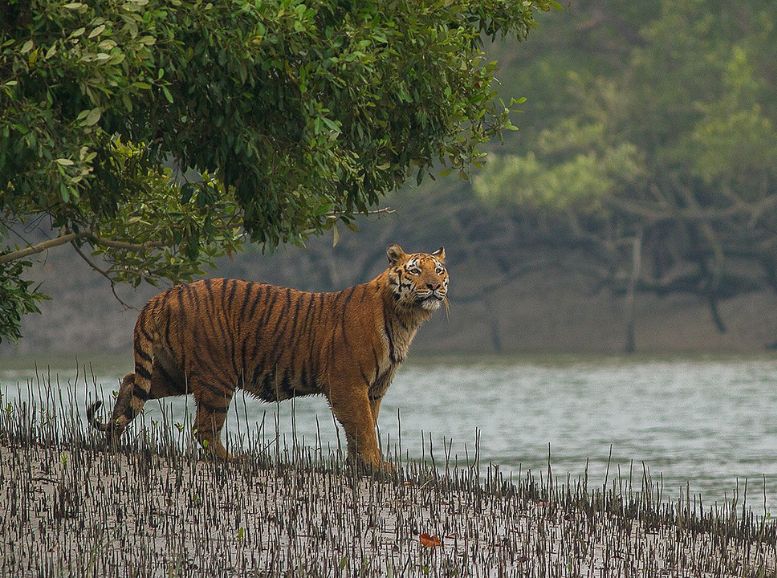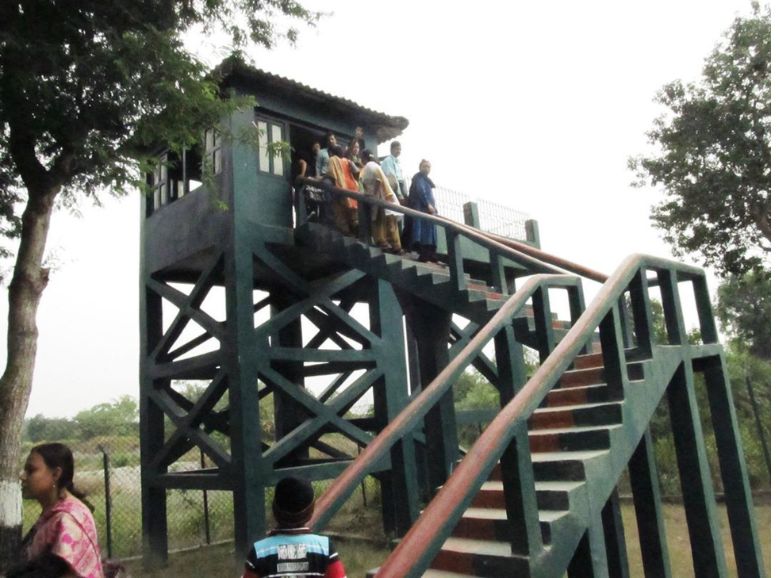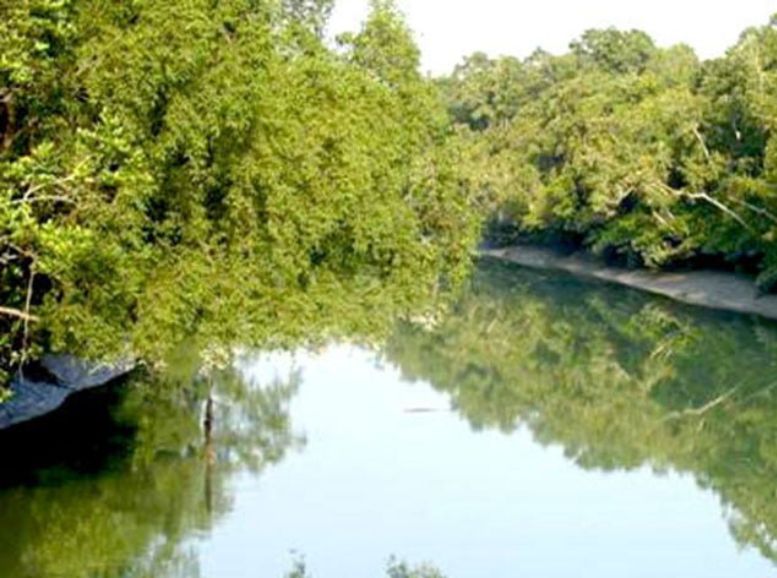Embark on a journey to the enigmatic Sunderbans National Park, where the confluence of land and water creates a realm of breathtaking beauty and adventure. Nestled in the Bengal delta, this UNESCO World Heritage Site is a tapestry of mangrove forests, serpentine rivers, and teeming wildlife, waiting to be explored and experienced.
In this travel guide, we’ll delve into the uncharted territories of Sundarbans, uncovering the secrets of its primeval forests, and revealing the hidden gems of its vibrant ecosystem. From the majestic roars of the Bengal tiger to the gentle whispers of the mangrove trees, and from the intricate networks of riverine life to the resilient spirit of the local communities, we’ll navigate every aspect of this natural wonder, and empower you to craft your own unique adventure in the Sundarbans.
How to reach:
Taking Flight:
For a smooth start to your adventure, fly into Netaji Subhas Chandra Bose International Airport in Kolkata. This well-connected airport offers domestic and international connections, making it easy to reach your starting point. Upon arrival, taxis and public transportation are readily available to whisk you away to the next leg of your journey, be it a train station or bus stand.
Train Travel:
For a budget-friendly and scenic option, consider traveling by train. The nearest station to Sunderbans is Canning, roughly 48 kilometers away. Local trains departing from Sealdah Railway Station in Kolkata reach Canning in approximately 1.5 hours. This train journey provides a delightful glimpse into the rural charm of West Bengal and brings you closer to the park. Keep in mind that further travel by road and boat is necessary from Canning to reach the park itself.
Road Trip:
If you prefer a road journey, a trip from Kolkata to Godkhali, the gateway to the Sunderbans, is a popular choice. This 95-kilometer drive takes about 3 hours by taxi or bus. The scenic countryside of West Bengal unfolds as you pass through small towns and villages. Godkhali serves as the main point for boat tours into the Sunderbans, making road travel an essential part of the adventure.
Best time to visit:
Winter (November to February):
Embrace comfortable temperatures (10°C to 30°C) during Sunderbans’ winter. Explore by boat or foot with ease and witness the majesty of the Royal Bengal Tiger and a dazzling array of birds as cooler weather brings them out. Clear skies and lower humidity ensure breathtaking vistas of the park’s natural beauty. This is the prime season for an unforgettable wildlife adventure.
Monsoon (June to September):
The monsoon transforms Sunderbans into a verdant paradise. Lush foliage explodes, but heavy rainfall can disrupt boat trips and limit access to some areas. High humidity adds to the challenge, and spotting wildlife can be trickier due to the dense vegetation. If you can brave the rain and prefer a secluded experience, the monsoon unveils a unique side of Sunderbans’ charm.
Summer (March to May):
Sunderbans summers are scorching (up to 42°C) with high humidity. The intense heat makes outdoor activities uncomfortable, and wildlife seeks cooler areas, reducing your chances of sightings. While the park is always open, summer is generally not recommended for an enjoyable exploration
Attractions:
Sajnekhali Watchtower:

The Sajnekhali Watchtower, a popular attraction in Sunderbans National Park, offers a prime spot for wildlife observation. Nestled near the Sajnekhali Bird Sanctuary, the tower grants strategic views of a diverse range of animals. Keep your eyes peeled for the elusive Royal Bengal Tiger, graceful spotted deer, lurking crocodiles, and even wild boars.
The watchtower’s strategic location near the meeting point of several rivers is key. Animals are drawn to these water bodies, making sightings more likely. Bird enthusiasts will be especially delighted, as the adjacent sanctuary boasts an impressive collection of avian species. From colorful kingfishers to majestic herons, egrets, and storks, the variety is astounding. Winter brings an even richer display of birdlife, as migratory species join the resident birds.
Sudhanyakhali Watchtower:

Panoramic vistas await at the Sudhanyakhali Watchtower, another prominent spot within Sunderbans National Park. This watchtower is a haven for wildlife enthusiasts, particularly those seeking a glimpse of the majestic Royal Bengal Tiger. A nearby freshwater pond acts as a magnet, drawing tigers and other animals like deer, wild boars, and even basking crocodiles.
Beyond the exciting potential for tiger sightings, Sudhanyakhali offers a feast for the eyes. The surrounding area boasts a diverse array of mangrove plant life, adding to the natural beauty. The watchtower’s height grants a unique perspective, allowing visitors to observe the vast forest canopy and the intricate network of water channels that define the Sunderbans’ complex ecosystem. Photographers and nature lovers will find Sudhanyakhali an ideal spot to capture the essence of this remarkable park.
Royal Bengal Tiger:

The crown jewel of Sunderbans National Park is undeniably the Royal Bengal Tiger. Boasting one of the world’s largest populations, the Sunderbans provide a unique chance to witness these magnificent predators in their natural domain. Unlike their mainland counterparts, these tigers are adept swimmers, perfectly adapted to the mangrove ecosystem. Spot them crossing rivers with ease or navigating the dense undergrowth. Sightings are most promising near water bodies and clearings, where tigers hunt and quench their thirst. The very possibility of encountering a Royal Bengal Tiger, with its fiery orange coat and bold black stripes, ignites the thrill in every visitor.
Protecting these endangered animals is paramount. Conservation efforts in the Sunderbans strive to ensure their continued existence in a sustainable environment. For wildlife enthusiasts and photographers, capturing a glimpse of a Royal Bengal Tiger in the wild is an unparalleled experience, transforming every visit into an exhilarating adventure.
Netidhopani Watchtower:

Steeped in both natural beauty and historical intrigue, Netidhopani Watchtower is a must-visit in Sunderbans National Park. Panoramic vistas unfold from the tower, showcasing the dense mangrove forests and snaking waterways. But Netidhopani offers more than breathtaking views. The site cradles the ruins of a 400-year-old temple, adding a layer of cultural and historical fascination. This unique blend of wildlife and historical remnants makes Netidhopani a captivating destination. The surrounding area is known for frequent tiger sightings, along with sightings of deer and diverse birdlife. A visit to Netidhopani Watchtower allows you to delve into both the natural wonders and the cultural heritage of the Sunderbans, creating a truly enriching experience.
Tin Kona Island:

A haven for wildlife enthusiasts, Tin Kona Island is renowned for its untamed beauty and diverse inhabitants. Dense mangrove forests cloak the island, providing refuge for tigers, deer, and a dazzling array of bird species. Boat trips weave through the surrounding waters, offering close-up views of the lush vegetation and the creatures that call it home. Tin Kona Island’s remoteness creates a pristine environment, perfect for experiencing the raw essence of the Sunderbans. The island’s magic extends beyond the land. The surrounding waterways are a haven for dolphins and crocodiles, adding to the spectacle of wildlife sightings. This untamed island is a favorite among adventure seekers and nature lovers, a place where the wild spirit of the Sunderbans reigns supreme.
Hiron Point, Sunderbans National Park:

Tin Kona Island beckons wildlife enthusiasts with its untamed beauty and rich tapestry of life. Dense mangrove forests envelop the island, creating a sanctuary for tigers, deer, and a dazzling array of birds. Boat tours navigate the surrounding waters, providing captivating close-up views of the lush vegetation and the creatures that inhabit it.
The island’s remoteness fosters a pristine environment, allowing visitors to experience the raw essence of the Sunderbans. But the magic extends beyond the land. The surrounding waterways teem with life, offering sightings of dolphins and crocodiles that enhance the spectacle of wildlife encounters.
Burirdabri Watchtower:

Believe it or not, some watchtowers in the Sunderbans offer an experience that goes way beyond spotting wildlife. Take Burirdabri Watchtower, for instance. It’s like a choose-your-own-adventure for nature enthusiasts! Here, you can ditch the usual sightseeing and get right into the heart of the mangroves.
Imagine squelching through the mud on a thrilling mud walk, truly feeling the unique terrain of the Sunderbans beneath your feet. Then, to delve deeper into the dense forest canopy, you can safely navigate a special cage trail, offering a secret peek at the incredible wildlife that thrives there.
Local Experiences:
1. Village Homestays: Immerse yourself in the traditional way of life by visiting local villages. Interact with villagers, learn about their customs and daily routines, and see how they coexist with the surrounding wildlife. Many villages offer homestays, allowing you to experience genuine local hospitality and savor delicious Bengali cuisine.
2. Livelihood Lessons: Join local fishermen on their fishing and crab-catching expeditions. Gain firsthand knowledge of their primary livelihood, learn about traditional techniques using handmade nets and traps, and understand the cultural significance of these activities.
3. Cultural Performances: Immerse yourself in the rich heritage of the Sunderbans through captivating folk performances. Witness Baul music and Jhumur dance, traditional expressions that tell stories of local folklore, legends, and the intricate relationship between the people and their environment.
4. Unveiling the Mangroves: Embark on guided walks through the mangrove forests. Local guides, often from the community, will share their extensive knowledge about the unique flora and fauna, medicinal plants, and the diverse wildlife that call the mangroves home.
5. The Art of Honey Collection: Witness (or even participate in!) the daring tradition of “Mouley,” honey collection. Watch skilled honey collectors, called “Mouals,” venture into the forest to gather honey from wild beehives, highlighting the bravery and skill required while respecting the dangers posed by wildlife.
6. Culinary Delights: Take a cooking class and learn to prepare traditional Bengali dishes using fresh, local ingredients. Discover the secrets behind seafood delicacies and the fragrant herbs and spices that define the region’s cuisine.
7. Riverine Relaxation: Unwind on a river cruise with local boatmen. Explore the intricate waterways, spot wildlife, visit remote islands, and soak in the serene beauty of the mangroves. All while learning about the local way of life from your knowledgeable guide.
8. Eco-Warriors Unite: Participate in eco-tours or visit local conservation projects. Gain an understanding of the ongoing efforts to protect the Sunderbans’ unique environment. These tours may include visiting rehabilitation centers, learning about the challenges of wildlife conservation, and supporting community-based tourism initiatives.
9. Prawn Seed Secrets: Observe or join locals in prawn seed collection, a common activity along the rivers and creeks. Understand the delicate process of collecting prawn larvae, which are then raised and sold in local markets, gaining insight into another important livelihood.
10. A Celebration of Local Produce: Explore the vibrant local markets, especially those in Canning and Gosaba. Immerse yourself in the daily commerce and culture as you browse through fresh produce, local seafood, aromatic spices, and handcrafted goods, reflecting the region’s rich natural resources and artisanal traditions.
Travel tips:
1. Timing is Everything: The sweet spot for visiting the Sunderbans is between November and February. Pleasant weather and increased wildlife activity make this the prime season. Avoid the monsoon season (June to September) with its heavy rain and potential flooding.
2. Permits in Place: Don’t forget the entry permits! These are usually arranged by your tour operator or obtained at entry points like Sajnekhali, where you’ll also find a Forest Office.
3. Book Your Stay Early: Due to the remote location and limited options, booking your accommodation well in advance is recommended. Choose from forest lodges, eco-resorts, or even homestays in nearby villages.
4. Guided by the Experts: Consider booking tours with reputable operators. Local guides with their extensive knowledge can elevate your wildlife experience while prioritizing safety.
5. Pack Smart: Light, breathable clothing is ideal for the daytime, with warmer layers for cooler evenings. Pack sturdy walking shoes, a hat, sunglasses, and sunscreen. Don’t forget insect repellent for those pesky mosquitoes.
6. Stay Hydrated and Fueled: Pack enough water and snacks, as amenities might be limited in remote areas. Staying hydrated is crucial, especially during boat trips and walks.
7. Capture the Magic: Binoculars are a must for spotting distant wildlife. Bring a good camera with a zoom lens to document the unique flora and fauna of the Sunderbans.
8. Respect the Wild: Maintain a safe distance from animals, especially tigers and crocodiles. Refrain from feeding wildlife and follow your guide’s instructions to ensure both your safety and minimal disturbance to the animals.
9. Be a Smooth Sailor: Much of the exploration within the Sunderbans happens by boat. If prone to seasickness, pack medication. Ensure your boat has life jackets and other safety gear.
10. Stay Connected (When Possible): Mobile network coverage can be patchy. Inform loved ones about your travel plans and update them whenever possible. Consider carrying a portable charger for your devices.
Conclusion
Unveil the magic of Sunderbans National Park, a captivating blend of rich wildlife, cultural heritage, and stunning landscapes. Witness the majestic Royal Bengal Tiger or get lost in the serene beauty of the vast mangrove forests. Xplro.com, your adventure travel companion, goes beyond the usual to connect you with the heart of the Sunderbans. Explore local villages, join fishing expeditions, and immerse yourself in folk performances. Plan your visit for the ideal winter months (November to February) and let Xplro.com handle the permits, reputable tours, and responsible travel practices. Navigate the intricate waterways, participate in conservation projects, or simply marvel at the diverse wildlife – the Sunderbans promises a journey of unforgettable discovery. Visit Xplro.com today to unlock the secrets of this remarkable park and craft your Sunderbans adventure.
FAQs
What is the ideal time to visit Sunderbans National Park?
- The optimal time to explore Sunderbans National Park is between November and February, offering agreeable weather conditions and increased chances of wildlife sightings.
How can I access Sunderbans National Park?
- Accessing Sunderbans National Park typically involves air travel to Kolkata, followed by road and boat transportation to the park’s entry points.
What kinds of wildlife are prevalent in Sunderbans?
- Sunderbans is renowned for its diverse wildlife, including the Royal Bengal Tiger, spotted deer, crocodiles, and numerous avian species.
Are guided tours available in Sunderbans?
- Yes, visitors can partake in guided tours facilitated by knowledgeable local guides, enhancing their exploration of the park.
Are permits required to enter Sunderbans National Park?
- Yes, permits are mandatory for entry into Sunderbans National Park and can be obtained through tour operators or at designated entry points.
What essential items should I pack for my trip to Sunderbans?
- Packing essentials include light clothing, sturdy footwear, insect repellent, sunscreen, binoculars, cameras, and any required medications.
What lodging options are available in Sunderbans?
Answer: Sunderbans offers various accommodation choices such as forest lodges, eco-resorts, and homestays within nearby villages.
Is tiger spotting possible in Sunderbans National Park?
- Yes, Sunderbans National Park is renowned for its Royal Bengal Tigers, with visitors having the opportunity to spot them during guided safaris.
What safety precautions should I consider in Sunderbans National Park?
- It is crucial to adhere to safety guidelines provided by tour guides, maintain a safe distance from wildlife, and ensure readiness for boat travel, including life jackets and medications.
Are there cultural experiences to partake in Sunderbans National Park?
- Yes, visitors can engage in cultural encounters such as village visits, traditional performances, and culinary classes, offering insights into local traditions.
Is it advisable to visit Sunderbans National Park during the monsoon season?
- It is not recommended to visit Sunderbans during the monsoon season (June to September) due to heavy rainfall and potential flooding.
How long should I plan my stay in Sunderbans National Park?
- A suggested duration for a comprehensive exploration of Sunderbans National Park is at least 2-3 days, ensuring ample time to appreciate its diverse attractions.





